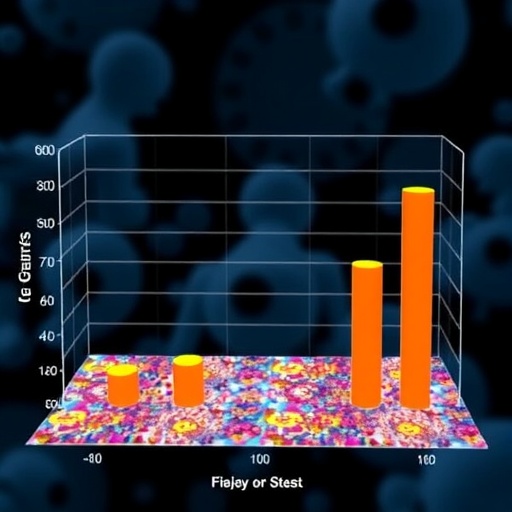
Credit: The Scripps Research Institute
JUPITER, FL – June 19, 2017 – Scientists on the Florida campus of The Scripps Research Institute (TSRI) have improved a state-of-the-art gene-editing technology to advance the system's ability to target, cut and paste genes within human and animal cells — and broadening the ways the CRISPR-Cpf1 editing system may be used to study and fight human diseases.
Professor Michael Farzan, co-chair of TSRI's Department of Immunology and Microbiology, and TSRI Research Associate Guocai Zhong improved the efficiency of the CRISPR-Cpf1 gene editing system by incorporating guide RNAs with "multiplexing" capability.
Guide RNAs are short nucleic acid strings that lead the CRISPR molecular scissors to their intended gene targets. The TSRI discovery means multiple genetic targets in a cell may be hit by each CRISPR-Cpf1 complex.
"This system simplifies and significantly improves the efficiency of simultaneous editing of multiple genes, or multiple sites of a single gene," Zhong said. "This could be very useful when multiple disease-related genes or multiple sites of a disease-related gene need to be targeted."
"This approach improves gene editing for a number of applications," Farzan added. "The system makes some applications more efficient and other applications possible."
This study was published as an advanced online paper in the journal Nature Chemical Biology on June 19, 2017.
TSRI Advance Makes CRISPR More Efficient
Short for "Clustered Regularly Interspaced Short Palindromic Repeat," the CRISPR gene editing system exploits an ancient bacterial immune defense process. Some microbes thwart viral infection by sequestering a piece of a virus' foreign genetic material within its own DNA, to serve as a template. The next time the viral sequence is encountered by the microbe, it's recognized immediately and cut up for disposal with the help of two types of RNA. Molecules called guide RNAs provide the map to the invader, and CRISPR effector proteins act as the scissors that cut it apart.
Over the last five years, the CRISPR gene editing system has revolutionized microbiology and renewed hopes that genetic engineering might eventually become a useful treatment for disease.
But time has revealed the technology's limitations. For one, gene therapy currently requires using a viral shell to serve as the delivery package for the therapeutic genetic material. The CRISPR molecule is simply too large to fit with multiple guide RNAs into the most popular and useful viral packaging system.
The new study from Farzan and colleagues helps solve this problem by letting scientists package multiple guide RNAs.
This advance could be important if gene therapy is to treat diseases such as hepatitis B, Farzan said. After infection, hepatitis B DNA sits in liver cells, slowly directing the production of new viruses, ultimately leading to liver damage, cirrhosis and even cancer. The improved CRISPR-Cpf1 system, with its ability to 'multiplex,' could more efficiently digest the viral DNA, before the liver is irrevocably damaged, he said.
"Efficiency is important. If you modify 25 cells in the liver, it is meaningless. But if you modify half the cells in the liver, that is powerful," Farzan said. "There are other good cases–say muscular dystrophy — where if you can repair the gene in enough muscle cells, you can restore the muscle function."
Two types of these molecular scissors are now being widely used for gene editing purposes: Cas9 and Cpf1. Farzan said he focused on Cpf1 because it is more precise in mammalian cells. The Cpf1 molecule they studied was sourced from two types of bacteria, Lachnospiraceae bacterium and Acidaminococus sp., whose activity has been previously studied in E. coli. A key property of these molecules is they are able to grab their guide RNAs out of a long string of such RNA; but it was not clear that it would work with RNA produced from mammalian cells. Guocai tested this idea by editing a firefly bioluminescence gene into the cell's chromosome. The modified CRISPR-Cpf1 system worked as anticipated.
"This means we can use simpler delivery systems for directing the CRISPR effector protein plus guide RNAs," Farzan said. "It's going to make the CRISPR process more efficient for a variety of applications."
Looking forward, Farzan said the Cpf1 protein needs to be more broadly understood so that its utility in delivering gene therapy vectors can be further expanded.
###
In addition to Farzan and Zhong, the authors of the study, "Cpf1 proteins excise CRISPR RNAs from mRNA transcripts in mammalian cells," included Haimin Wang, and Mai H. Tran of TSRI; and Yujun Li of TSRI and Wu Lien-Teh Institute, Harbin Medical University, Harbin, China.
The study was supported by the National Institutes of Health (grants R37 AI091476 and P01 AI100263).
About The Scripps Research Institute
The Scripps Research Institute (TSRI) is one of the world's largest independent, not-for-profit organizations focusing on research in the biomedical sciences. TSRI is internationally recognized for its contributions to science and health, including its role in laying the foundation for new treatments for cancer, rheumatoid arthritis, hemophilia, and other diseases. An institution that evolved from the Scripps Metabolic Clinic founded by philanthropist Ellen Browning Scripps in 1924, the institute now employs more than 2,500 people on its campuses in La Jolla, CA, and Jupiter, FL, where its renowned scientists — including two Nobel laureates and 20 members of the National Academies of Science, Engineering or Medicine — work toward their next discoveries. The institute's graduate program, which awards PhD degrees in biology and chemistry, ranks among the top ten of its kind in the nation. In October 2016, TSRI announced a strategic affiliation with the California Institute for Biomedical Research (Calibr), representing a renewed commitment to the discovery and development of new medicines to address unmet medical needs. For more information, see http://www.scripps.edu.
Media Contact
Greg Block
[email protected]
858-784-7369
@scrippsresearch
http://www.scripps.edu
############
Story Source: Materials provided by Scienmag





